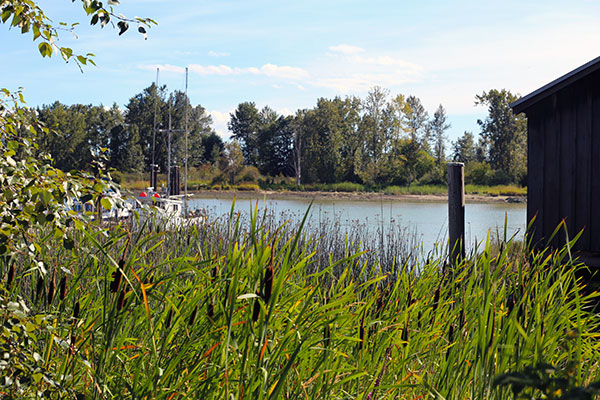Britannia Shipyard
National Historic Site Designation
The Britannia Shipyard was designated a National Historic Site in 1991 by the National Historic Sites and Monuments Board of Canada. The 3.3-hectare park is located along the Steveston Channel of the Fraser River in Steveston Village. The Britannia Shipyard was constructed as a cannery in 1890, a function it retained until 1918, after which it was adapted for use as a boat repair yard until 1980.
The property includes the Britannia Shipyard and two boatworks operated by Japanese-Canadians. Labourers and craftsmen of Chinese, European, First Nations and Japanese descent lived in houses on site, and worked in salmon canneries, on the fishing boats, and in the boatworks. The community of workshops and dwellings served the shore-based salmon fishery during its boom years from 1890 to 1913. Built over water, the shipyard is part of Steveston’s Cannery Row extending from Garry Point and the Gulf of Georgia Cannery to London Heritage Farm. Many of the buildings on the site were built in 1885.
The Anglo British Columbia Packing Company (ABC) converted the canneries into the Britannia Shipyard in 1917 for the winter housing and repair of its cannery fleet. Managers, foremen, shipwrights, machinists, carpenters, welders, painters, general labourers, bookkeepers, stockmen, and many others were employed to run the new shipyard. ABC owned and operated the shipyard until 1969 when it was sold to the Canadian Fishing Company. In 1979, Britannia Shipyard was sold to BC Packers, and all parts, machinery and equipment were moved to other BC Packers’ properties. Employees were laid off in the spring of 1980.
Murakami Boatworks
The Murakami family built a boatworks in 1929 on property rented from the Phoenix Cannery. Otokichi Murakami built two boats every winter, and then fished during the summer. Japanese and Western tools were used to build one boat at a time. Using temporary rails, completed boats were directed across the front boardwalk for launching. A hand-operated capstan was used to move the cradle along the rails. Today, the boatworks is home to boatbuilding programs and maritime demonstrations.
Seine Net Loft
The large net loft was built around 1954 for the Anglo British Columbia Packing Company, who owned the Britannia site from 1892 until 1969. Originally constructed as a seine net loft, it has more recently been used as a storage facility. Net lofts were constructed at cannery sites all along the Steveston waterfront to store and repair fishing nets. Their location on pilings over the water made it easy for fishermen to load and unload their nets from the fishing boats. Their large size and cavernous interiors were designed to facilitate the suspension of large nets for drying.
Boatbuilding Industry
From 1918 to 1979, Britannia Shipyard employees maintained and repaired boats belonging to the ABC Packing Company. The carpentry, engine and machine shops were busy places. There were always boats waiting to be repaired for the coming fishing season.
The first commercial boats used for salmon fishing were Fraser River Skiffs. These boats were flat bottomed, and double-enders with pointed bow and pointed stern. However, the pointed stern presented difficulties when the nets were pulled in.
Columbia River boats were 25-foot fixed mast, round-bottomed boats that replaced Fraser River Skiffs in the early 1890s. The rounded hull bottoms were more sea worthy in design.
Fraser River Skiffs and Columbia River Boats were fragile and prone to swamping in stormy weather. This prompted Japanese boat builders to begin designing sturdier boats, adding decks, and later, cabins.
Shady Island and Storm Protection
Shady Island, across the channel, was once a small sandbar providing minimal protection from storm winds and high waves. In 1955, two rock jetties were constructed on the island to more clearly define the Steveston Channel and provide better protection for the Steveston waterfront. This hastened the process of sand accumulation, resulting in the formation of the island.
The wooden bulkhead south of the boardwalk was built as a breakwater to help keep waves from washing over the boardwalk and into buildings. This is the last place in Richmond where this type of bulkhead construction exists. The boardwalk and bulkhead are important parts of Britannia’s heritage, and were reconstructed in the 1990s. Part of Steveston is located on reclaimed land from the Fraser River. Earth used as infill came from river dredging in the 1950s and 60s.

Britannia Shipyards National Historic Site
5180 Westwater Drive
Richmond, British Columbia
(604) 718-8050
britannia@richmond.ca
Summer
May 1 to September 30
Monday to Sunday
10:00 AM to 5:00 PM
Winter
October 1 to April 30
Saturday and Sunday
12:00 PM to 5:00 PM



